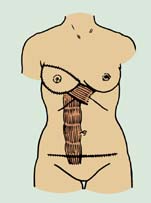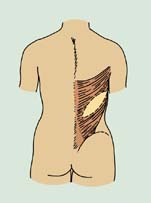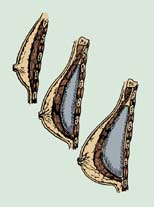Breast Reconstruction
Restoring Your Wholeness
For some women, having her breast reconstructed is a helpful step in her spiritual and emotional healing process after a successful battle with breast cancer. The goal of breast reconstruction is to restore a soft, symmetrical breast and eliminate the need to wear an external prosthesis.
Downey Plastic Surgery practices highly individualized care based on patient needs, which are jointly identified during a thorough consultation and examination. Dr. Downey will discuss the treatment options available for reconstructing a breast or breasts after a mastectomy or lumpectomy (partial mastectomy), and provide you a plan of care individualized for your unique situation.
During this process, Dr. Downey will learn more about the goals you have set for breast reconstruction. He will review the entire treatment journey with you, including anticipated results, possible risks and recovery expectations.
Breast Reconstructive Surgery
Breast reconstruction procedures generally fall into two categories: those which use your own tissue exclusively (autogenous) to reshape your breast, and those which require a breast implant to replace the missing volume after mastectomy (implant techniques).
Patients who have had radiation treatments to the chest after breast cancer surgery generally undergo breast reconstruction with autogenous (your own tissue) techniques which replace the radiation-treated, tighter skin. There are exceptions to this philosophy which sometimes permit the use of implants for breast reconstruction, depending upon the recovery of your skin from mastectomy and radiation therapy.
Autogenous Techniques – Autogenous procedures are performed under general anesthesia and use tissue from your stomach, back, hip, or buttocks to reconstruct the breast. Two examples of these surgeries are detailed below.

A TRAM (Transverse Rectus Abdominis Muscle) flap procedure uses available loose skin and fat from the lower abdomen to reshape one or both breasts. The location of tissue used resembles the tissue removed in a cosmetic operation called an abdominoplasty or “tummy tuck”.
This tissue is left attached to an abdominal muscle, the rectus abdominus, which provides it with a continuous circulation of blood. During the procedure, the lower abdominal skin and fat is elevated from the abdominal site, pivoted and transposed to the breast area, and then shaped to match the opposite breast. To keep the breasts symmetrical, the other breast is sometimes also modified to be smaller, larger or more elevated.
 The latissimus dorsi flap procedure uses tissue from the back. An oval of skin is elevated over the midback and the underlying latissimus muscle, a broad, sheetlike muscle, is elevated off the back along with the skin. This muscle is shifted to the breast area and an inflatable implant is placed beneath the muscle. To make a full, relaxed breast, the implant is gradually filled to stretch the chest skin and weeks later it is replaced with a permanent breast implant. At this final operation, the opposite breast is sometimes also modified to maintain symmetry.
The latissimus dorsi flap procedure uses tissue from the back. An oval of skin is elevated over the midback and the underlying latissimus muscle, a broad, sheetlike muscle, is elevated off the back along with the skin. This muscle is shifted to the breast area and an inflatable implant is placed beneath the muscle. To make a full, relaxed breast, the implant is gradually filled to stretch the chest skin and weeks later it is replaced with a permanent breast implant. At this final operation, the opposite breast is sometimes also modified to maintain symmetry.
 Tissue Expander Implant – Reconstruction of the breast can also be achieved by the use of a special type of inflatable breast implant called a tissue expander. In general, patients choose this method of reconstruction because it involves only operating upon the skin and muscle of the chest area, and nowhere else. Also, the requirement for hospitalization and time away from work and family life are shorter with this technique.
Tissue Expander Implant – Reconstruction of the breast can also be achieved by the use of a special type of inflatable breast implant called a tissue expander. In general, patients choose this method of reconstruction because it involves only operating upon the skin and muscle of the chest area, and nowhere else. Also, the requirement for hospitalization and time away from work and family life are shorter with this technique.
Patients who have this operation generally have elastic, non-radiated skin, and have small to moderately sized breasts. This operation can be performed at the same time as a mastectomy, in a method called immediate reconstruction.
The tissue expander technique is performed in two stages of operations. During the initial operation, a pocket is surgically made beneath the skin and muscle on the chest wall. The tissue expander is placed into the pocket and is then partially filled. During a later series of visits, Dr. Downey will add more saline to the implant until the expander is full enough to accommodate the final implant.
In a second operation, using the same scar, the expander is removed, and a final implant filled with either saline or silicone gel is put in its place. At this time, the opposite breast is also modified by enlargement, reduction, or lifting to ensure symmetry.
Nipple and Areola Reconstruction – Nipple and areola reconstruction is a procedure chosen by many women after the reconstruction of a breast. First, the nipple is reconstructed using breast skin at the apex of the completed breast mound. This is accomplished using local anesthesia in our office operating rooms. Once the nipple heals, the areola is created also under local anesthesia using natural pigment layered into the skin to impart a natural shape, hue, and outline.
Recuperation and Aftercare
Depending on the type of surgery, you may need to stay overnight in the hospital. Pain following surgery is typically of mild to moderate intensity and oral pain medication usually works very well to keep you comfortable. For some procedures, a small drain tube is placed under the skin during surgery to help control swelling for a few days following the operation.
Most people return to light work one or two weeks following the tissue expander placement and four to six weeks after a TRAM or latissimus dorsi procedure. You should be up and around daily but should refrain from exercise and other strenuous activity until directed by Dr. Downey.
It may take as long as a year for tissues to completely heal and for scars to fade, but you will begin to appreciate the convenience of better breast symmetry and balance almost immediately after your reconstruction surgery.
Risks of Surgery
Complications of breast reconstruction surgery are explained fully during consultation. These could include reaction to anesthesia, bleeding, infection, numbness, asymmetry, loss of some breast reconstruction tissue, problems in the back or abdominal area (where tissue originated) or clot formation in the leg. Any breast tissue removed during your surgery is analyzed fully by a pathologist doctor after the operation. Abnormal tissue discovered from the analysis could require additional treatments including more surgery.
Risks associated with implants include bleeding, infection of the incision or of the implant pocket, numbness of the skin or nipple, implant leak or deflation, continued asymmetry of breast size or position, capsular contracture (a tightening of scar tissue around the implant, making the breast feel hard), opening of the incision and exposure of the implant, and interference with mammography or self-examination.
As with all surgeries, risks increase with smoking, obesity, diabetes, age and other medical conditions. You should discuss with us any medications, especially blood thinners, as well as natural or herbal remedies, to help avoid complications with your operation.
Great care is taken around the time of your operation to reduce these risks. After the surgery, your job is to control your pain, remain active and keep your incisions clean and dry. Communicate with us anytime if you have any questions or concerns about how you are doing.
Financial Considerations
Health insurance policies often cover most or all of the cost of reconstruction after a mastectomy, although there may be limits on the types of reconstruction that are covered. Sometimes your insurance company will deny breast reconstruction costs if you have already submitted claims for a breast prosthesis.
Downey Plastic Surgery will help coordinate with your insurance carrier if you desire. For more information, please visit the financial section of our web site.

